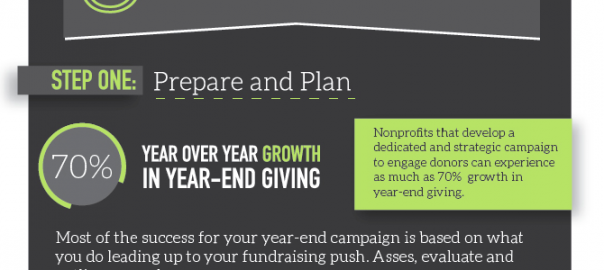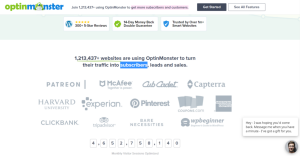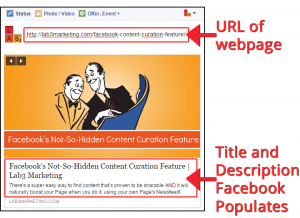Did you know that 50% of nonprofits receive a majority of their annual donations from October through December? It’s true, and it’s why you need to take your year-end fundraising campaigns seriously.
But fear not! We’ve teamed up with our friends from Pursuant to create a step-by-step guide to year-end giving. Share this resource and keep it handy as you plan your fourth quarter campaigns:
Here are the three steps you can take to make the most of year-end giving to achieve (and hopefully exceed) your annual fundraising goals:
Step One: Prepare and Plan
Preparation is everything. That’s why October (or earlier!) is a great time to start thinking about year-end.
Action Items:
- Assess past year-end giving results and define your goal. If you don’t know what you want to accomplish, you’re unlikely to achieve anything.
- Evaluate your data and segment your donors. The strongest year-end campaigns are based on extensive donor analytics and segmentation (i.e. – past giving, wealth overlays and behavioral indicators).
- Outline your communications based on key dates and donor preferences. Develop a communications calendar for October, November and December for each segment of your donors with key dates for each touch point. The more specific you can be in your asks, the better your results will be.
Takeaway: Most of the success for your year-end campaign is based on what you do leading up to your fundraising push.
Step Two: Craft a Compelling Story and Integrate Your Communication Channels
74% of donors say that their primary reason for giving is because “the holidays are a time to be thankful for what you have, and give to those who need it.” Are you properly communicating your need?
Action Items:
- Build your case for support around individual stories and compelling examples of how your nonprofit is making an impact. Maximize your effectiveness by building your case for support around individual stories. Put a face on your appeal. A compelling story indicates why you need your donor’s help and why the funds are important now.
- Make gifts as tangible as possible. Show donors how their gift will impact your cause (i.e. – meals served, houses built, or animals vaccinated) and how much is needed to reach your goal so they understand the value of supporting your mission.
- Integrate your communication channels for maximum impact. Include links to online donation pages in direct mail pieces. Offer donors multiple ways to give so they can choose their preference.
- Stagger your communication at least every two weeks until mid-December. Maintain a balance between the most effective communication mediums. Most people are getting pummeled by offers from other organizations. If you stop communicating, you will fade into the distance. Donor value can increase from $ 100 based on one channel to as high as $ 200-250 using multiple channels!
Takeaway: Identify your most compelling stories and case for support then look for ways to integrate them in a multi-channel approach.
Step Three: Elevate Your Campaign for a Strong Year-End Push
33% of donations made in December occur on the 31st of the month. Be prepared for last-minute year-end donors!
Action Items:
- Optimize your website for year-end giving. Update the homepage of your website to feature your year-end giving campaign. Make it as easy as possible for donors to directly connect to your donation page.
- Send weekly communication pieces the last two weeks of the year. Most donors know they will make a year-end gift, but some are still undecided about how much they will give. Continue to share your case for support and make it easy for them to give at the last moment.
- Send daily digital communication pieces the last four days of the year. Most of the communication at this point will happen online via e-mails, social media, video mail, etc. Consider sending the first of your final emails to everyone in your entire donor file who hasn’t given. For the next send, suppress the names of those who opened the previous last-chance email and resend the email again.
Takeaway: Don’t miss the opportunity to make the most of every day at the end of the year. Donors are busy and you should be strategic in your final year-end ask.
What are your plans for the end of the year? Let us know in the comments below!
Sources:
The Effect of the Economy On the Nonprofit Sector (GuideStar)
THE TOP 10 THINGS you should know for a strong year-end campaign (Pursuant)
Pursuant helps Awana International Boost Year-End Results (Pursuant)
Year-End Giving Trends: 2013 Poll Results (Charity Navigator)
10 Tips for Year-end Fundraising (National Main Street Center)
More Proof That December Is Critical to Charities’ Annual Giving (The Chronicle of Philanthropy)
3 Tips and a BIG Christmas Bonus to Supercharge Year-End Online Giving (npEngage)
Business Articles | Business 2 Community
(385)
Report Post
![A Step by Step Guide to Year End Giving [Infographic] A Step by Step Guide to Year End Giving [Infographic] image Year End Infographic final670.png](http://www.onlinesalesguidetip.com/wp-content/uploads/2014/10/Year-End-Infographic-final670.png.png)






